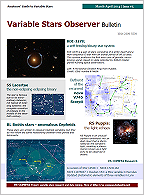Variable Stars Common Observation
Mission in Particular Areas of the Sky
Gaia space observatory launched into space
 by Ivan Adamin in
November-December 2013 (#3)
by Ivan Adamin in
November-December 2013 (#3) The five-year-long space trip of the telescope named Gaia started from Kourou in French Guiana on Thursday, December 19, 2013 at 9:12 UTC, where it was taken off on top of a Russian-built Soyuz-Fregat launch vehicle. The Gaia spacecraft is a successor to the Hipparcos satellite that was launched by Arianespace in 1989. The main purpose of the satellite telescope is to build the most detailed 3D map of the Milky Way galaxy.
The name ‘GAIA’ was originally derived as an acronym for Global Astrometric Interferometer for Astrophysics Gaia mission has been in development for 20 years, as a part of long-term ESA's space research program.
The 2,120 kg spacecraft will be placed into deep space in an orbit that will be of a Lissajous-type around the second Lagrange point (L2), at a distance of 1.5 million kilometers from Earth (0.01 AU).
Gaia will create a highly accurate three-dimensional map of stars throughout the Milky Way galaxy and map their motions. This will help to understand subsequent evolution of the Milky Way better. During its 5-years mission, Gaia will monitor each of its target stars about 70 times.
It is hoped that Gaia will give astronomers an extremely precise realistic picture of the Milky Way galaxy structure and evolution. Measuring the astrometric and kinematic properties of a star is necessary in order to understand the various stellar populations, especially the most distant ones.
Eventually, a billion-star catalog of stars will be created. A billion of stars might be roughly one percent of the galaxy; however the previous research mission the Hipparcos catalogued a thousand times less celestial objects between 1989 and 1993.
Data gathered by the telescope will surely uncover tens of thousands of previously unseen objects. Besides new asteroids in our Solar System and exploding stars – supernovas – in other galaxies, scientists look forward to the opportunity of finding new planets around nearby stars.
The satellite is equipped with two key telescopes with 1.45 x 0.5m primary mirror each. Telescopes are projecting light from stars onto 1.0 x 0.5m focal plane array, which consists of 106 CCDs of 4500 x 1966 pixels each. To measure the radial velocity an integrated spectrometer observing the Doppler effect is used.
Gaia will send back data for about eight hours every day at about 5 Mbit/s (about 200 TB of usable uncompressed data overall). ESA's two most sensitive ground stations, the 35 m diameter radio dishes in Cebreros, Spain, and New Norcia, Australia, will receive the data.
In October 2013 ESA had to postpone Gaia's original launch date, due to a precautionary replacement of two of Gaia's transponders, which are used to generate timing signals for the downlink of science data. Around 3 weeks is needed for Gaia to reach its designated orbit around the L2 point.
Interesting web resources to follow on the subject:
Free Bulletin on Variable Stars
Variable Stars Observer Bulletin is all about variable stars science. It's made by amateurs and for amateurs. Here simplified contemporary data about different aspects of variable stars research is published. The bulletin is scheduled for six issues per year.
Want to contribute an article? Feel free to contact us at:
http://www.vs-compas.belastro.net/bulletin-contribute
or please simply drop an email to [ivan dot adamin at gmail dot com]
 Issue #5
Issue #5
March-April 2014
Free Online
PDF Bulletin on Variable Stars
Amateurs' Guide to Variable Stars
Read Online as e-Magazine
In this issue:
 by Ivan Adamin
by Ivan Adamin
BL Bootis stars - anomalous Cepheids
 by Ivan Adamin
by Ivan Adamin
A revision of NSV 13538 = NSVS 17231162
 by Alexandr Ditkovsky
by Alexandr Ditkovsky
NSVS 11075037 = Dauban V53:
updated elements of a Mira variable in Hercules
 by Siarhey Hadon
by Siarhey Hadon
Pulsating variable stars and the Hertzsprung-Russell diagram
 by Siarhey Hadon, Ivan Adamin
by Siarhey Hadon, Ivan Adamin
RS Puppis: the light echoes calibrate standard candles for accurate distance measurements
 by Ivan Adamin
by Ivan Adamin
SS Lacertae: The non-eclipsing eclipsing binary
 by Ivan Adamin
by Ivan Adamin
>>View Full Contents

|
Statistics Overview
Variables by Type Variables by Magnitude Variables by Period Build Own Criteria |
